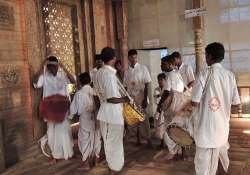Dhakis face uncertain future
Kolkata: ‘Dhakis' are integral to almost all festivities in Bengal but the art of playing the huge barrel-shaped membranophone instrument is dying a slow death.Most of the ‘dhakis' or men who play the ‘dhak' hail

Kolkata: ‘Dhakis' are integral to almost all festivities in Bengal but the art of playing the huge barrel-shaped membranophone instrument is dying a slow death.
Most of the ‘dhakis' or men who play the ‘dhak' hail from humble rural backgrounds of Murshidabad, Hooghly, Malda, Bankura, Malda and Purulia districts of the state.
Few are farmers and masons while others are into odd jobs for the rest of the year and wait for the festive season when they can earn some extra money.
“It was started by our forefathers. But it became their livelihood and continued to be so for a long long time until today when things have changed for the worse,” 34-year-old Tapas Das, a ‘dhaki' from Murshidabad said.
Das is a weaver by profession and he along with four members of his family has come to the city to play during the Durga puja festivities.
“You will not survive just by playing the dhak. My father understood this and started weaving sarees. He would play the ‘dhak' at Durga Puja in Kolkata to earn some extra money. I am only following his footsteps,” Das, who has been hired to perform at a renowned Durga Puja in the southern part of the city, said.
However, there are others for whom the passion to play the ‘dhak' and be appreciated is what draws them here during the Durga Pujas.
“It's not only to earn some extra money that we come here. Playing the dhak is in our blood which prompts us come here,” says Palash Dey from Hooghly.
Generally, four to five ‘dhakis' (at times eight to ten) form a team to perform at Durga Puja pandals and get a remuneration of around Rs 20000 to a maximum of Rs 30,000 for the four days of the festival.
But with the budget for the community pujas tightly drawn up, there is a dip in the demand for dhakis which is leading to a slow death of the popular art.
“Earlier, dhak was almost a compulsory feature even at Vishwakarma Pujas, Kali Pujas, besides of course Durga Puja.
“But these days most organisers are opting for recorded music for Vishwakarma and Kali pujas mainly because of budgetary constraints. It is killing the art,” dhaki Sunil Poddar, who hails from Bidhan Pally village in Maslandhapur in North 24-Parganas districts said.
In South India drummers and other traditional artists have ample opportunities all round the year to perform in temples and other festivals. Many ‘dhakis' lament that lack of opportunities and low remuneration have discouraged the younger generations from families of the traditional players from pursuing this art.
“Young people are preferred for playing dhaks because it involves a lot of energy. But we don't see young dhakis and the only few who come charge exorbitant rates,” an organising committee member of Behala ‘Notun Dal' community puja said.
There is bitterness in the words of 57-year-old Moni Shome, a dhaki who has performed at San Francisco, Chicago, New York, Los Angeles, Wellington and Berlin among other cities. “There is no money, no future in this profession. Tell me why will youngsters join this profession?”
“During our childhood we used to dream of performing at Durga Pujas and used to accompany elders who would come to Kolkata to perform.... But now convincing youngsters to join us is impossible,” the 57-year-old said.
According to Shome, the government should come forward in order to save the art.
“I think we must stop playing recorded music at pujas ... I think the government must come forward to save us and the tradition. Or else playing the dhak will be a lost art,” he said.